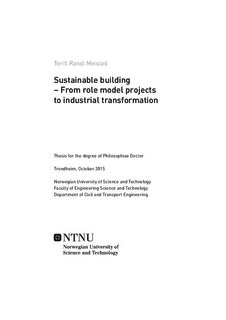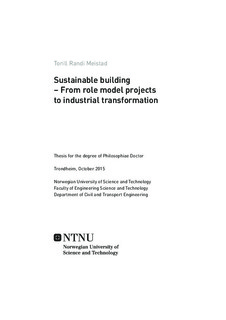| dc.contributor.author | Meistad, Torill Randi | |
| dc.date.accessioned | 2016-01-04T09:40:09Z | |
| dc.date.available | 2016-01-04T09:40:09Z | |
| dc.date.issued | 2015 | |
| dc.identifier.isbn | 978-82-326-1197-3 | |
| dc.identifier.issn | 1503-8181 | |
| dc.identifier.uri | http://hdl.handle.net/11250/2372394 | |
| dc.description.abstract | Background and purpose
Improving energy efficiency and sustainability is a challenge for the construction industry. The United Nation’s environment programme (UNEP) and the EU’s Energy Performance of Buildings Directive require a change in building practices. The challenge is how to facilitate the transformation.
The purpose of this PhD research is to increase the understanding of how the Norwegian construction industry is transforming towards sustainable building.
Four issues have been studied in this thesis to provide new knowledge relating to this question, as follows:
- Management of innovative energy-efficient building projects
- Usability of modern energy-efficient office buildings
- The role of facility managers in the planning process of ambitious projects
- Mechanisms in the industrial system affecting implementation of sustainable practice
Methodology and methods
Pioneering projects have proved that an outstanding energy and environmental performance can be achieved on a voluntary basis by owners and industry partners setting themselves ambitious goals. Eight Norwegian so-called role model projects have been studied to explore the processes and effect mechanisms that lead to the extraordinary results.
The material includes 55 interviews, observations of buildings when they are being used, project documents and written and oral presentations of the projects. The grounded theory approach has been used to perform case study analysis of this material.
Major findings
Ambitious tenant organizations represent a pull from the market and a knowledge resource for the development of sustainable buildings.
Facility managers are a source of practical experience that feed forward knowledge about the operation and energy performance of existing buildings to new projects.
Life cycle cost analysis provides information on long-term operational and maintenance costs, improving communication between property managers and decision makers and contributes to improving economic, community and environmental sustainability.
Enthusiasm is a driver for innovation and outstanding performance. Enthusiasm enables experienced owners, project managers and teams to find methods and solutions to bridge system barriers that resist change in industrial practice.
R&D partners provide new knowledge and reduce risks in initiatives for innovative sustainable building.
Usability is a key to the implementation of sustainable building. This includes area efficiency, an improved indoor climate and aesthetics, and functionality and adaptability for dynamic user organizations. Added value gained from exploring the synergy effects in energy-efficient building concepts is the key to increasing the demand for sustainable buildings from the market. At the moment, immature technology for indoor climate control is hampering the transformation of the construction industry.
Value of the research
The originality of this research is the analytical approach to sustainable building, namely the organizational dynamics. This approach illustrates how the organizing of relations between individuals in teams and between enterprises in projects affects the result, namely the energy performance of the final buildings.
The socio-technical system perspective provides new insight into the interplay between technology and human beings. Existing studies have shown how this interplay affects the actual energy performance of buildings when they are being used. This research adds insight into how management practice affects social processes that are relevant to the final energy performance of the building. And the research adds insight into the competition between existing industrial regimes and the emerging regimes of sustainable building.
Conclusions and suggestions
Research presented in this thesis can be summarized in four major conclusions:
1. The Norwegian construction industry is able to develop highly sustainable buildings. There are stakeholders within the industry that can be characterized as “innovators” and “early adopters” who explore the potential for energy efficiency in construction projects.
2. The organizing of the planning and construction process has been decisive for achieving the extraordinary results. Crossing the borders of organizational units, roles and the division of work in various phases has made it possible to pool knowledge, share risks and find innovative solutions to meet new expectations for sustainable building.
3. Currently, buildings with energy and environmental qualities higher than the mandatory technical regulations are exceptions to the rule within the construction industry. Sustainable building is being developed as a niche market. It still remains to be seen whether sustainable building will become standard practice.
4. The role model projects demonstrate that there is a win-win potential in sustainable building: exploring the synergy effects in a search for energy efficiency reveals options for buildings with added value for users and owners as well as the environment and the community.
The following are the author’s suggestions for strategies for further development of and transformation towards sustainable building:
- To develop building and refurbishment projects as part of a strategic business/organizational plan for the user organization/enterprise.
- To arrange for broad participation and early integration in project planning for the purpose of exploring the synergy effects of the energy performance, operation and usability of the final building
- To focus on the purpose of the building and the users. This supplements conventional technology orientation in project development.
To explore the principles for reflexive governance in a further development of strategies for transformation towards sustainable building.
A suggestion for further research is to focus on the implementation of sustainable building concepts and solutions from role models and other niches into ordinary practice in the Norwegian construction industry. Two issues are suggested for further exploration:
- Organizational learning from role model projects
- Stakeholder benefits from sustainable building – the potential for win-win effects | nb_NO |
| dc.language.iso | eng | nb_NO |
| dc.publisher | NTNU | nb_NO |
| dc.relation.ispartofseries | Doctoral thesis at NTNU;2015:270 | |
| dc.relation.haspart | Paper 1:
Meistad, Torill; Valen, Marit Støre.
ADDING VALUE AND SUSTAINABILITY BY INVOLVING FACILITY MANAGERS IN EARLY PLANNING. A PRELIMINARY STUDY OF NORWEGIAN ROLE MODEL PROJECTS OF ENERGY EFFICIENCIENT BUILDINGS. I: DELIVERING VALUE TO THE COMMUNITY - Proceedings of the Cape Town 2012 Joint CIB W070, W092 & TG72 | |
| dc.relation.haspart | Paper 2:
Meistad, Torill; Valen, Marit Støre; Lohne, Jardar.
USE OF COLLABORATIVE WORKING IN CONSTRUCTION PROJECTS WITH HIGH ENERGY AMBITIONS. 7th Nordic conference on construction economics and organization | |
| dc.relation.haspart | Paper 3:
Meistad, Torill.
PARTNERING FOR THE DEVELOPMENT OF AN ENERGY-POSITIVE BUILDING. CASE STUDY OF POWERHOUSE #1. 7th Nordic conference on construction economics and organization | |
| dc.relation.haspart | Paper 4: Meistad, Torill; Valen, Marit Støre; Klakegg, Ole Jonny.
Three stories describing the impact of research on the development of Norwegian Construction industry. CIB World Building Congress 2013 | |
| dc.relation.haspart | Paper 5:
Meistad, Torill.
How energy efficient office buildings challenge and contribute to usability. Smart and Sustainable Built Environment 2014 ;Volum 3.(2) s. 110-131 - Is not included due to copyright available at
https://doi.org/10.1108/SASBE-03-2014-0027 | |
| dc.relation.haspart | Paper 6:
Meistad, T.
Developing energy efficient buildings – beating the organizational challenge”,
Engineering Construction and Architectural Management | |
| dc.relation.haspart | Paper 7:
Meistad, Støre Valen, Brattås and Gissinger (2012)
“LCC as a decision tool for strategic development of the public building portfolio. A Norwegian
study.”
IALCCE 2012 | |
| dc.subject | sustainable building, energy-efficient performance, construction industry, role model projects innovation, organizing, project management, integration, collaboration, partnering, transformation | nb_NO |
| dc.title | Sustainable building – From role model projects to industrial transformation | nb_NO |
| dc.type | Doctoral thesis | nb_NO |
| dc.subject.nsi | VDP::Technology: 500::Building technology: 530::Building, construction and transport technology: 532 | nb_NO |

